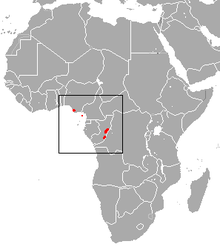Pennant's colobus
| Pennant's colobus | |
|---|---|
| Scientific classification | |
| Kingdom: | Animalia |
| Phylum: | Chordata |
| Class: | Mammalia |
| Order: | Primates |
| Family: | Cercopithecidae |
| Genus: | Procolobus |
| Subgenus: | (Piliocolobus) |
| Species: | P. pennantii |
| Binomial name | |
|
Procolobus pennantii (Waterhouse, 1838) |
|
 |
|
| Pennant's colobus range | |
| Synonyms | |
|
Piliocolobus pennantii |
|
Piliocolobus pennantii
Pennant's colobus or Pennant's red colobus (Procolobus pennantii) is a species of tree-dwelling primate in the family Cercopithecidae. It is endemic to tropical Central Africa. Three subspecies have traditionally been recognised but its distribution is peculiarly disjunct and has been considered a biogeographical puzzle. with one population on the island of Bioko (Equatorial Guinea), a second in the Niger River Delta in southern Nigeria, and a third in east-central Republic of Congo. It is found in rainforests and marshy forests. It is threatened by habitat loss and hunting for bushmeat. One subspecies, bouvieri, is rated as Critically Endangered; although it was last photographically documented in 2015, it may be on the brink of extinction.
Pennant's colobus was first described in 1838 by George Robert Waterhouse, curator at the Zoological Society of London's museum, and was named in honour of the naturalist and traveller Thomas Pennant. Three subspecies of this red colobus are traditionally recognized: The Bioko red colobus (Procolobus pennantii pennantii), the Niger Delta red colobus (Procolobus pennantii epieni) and Bouvier's red colobus (Procolobus pennantii bouvieri). However, Groves (2007) raised P. p. epieni, and P. p. bouvieri to Piliocolobus epieni and Piliocolobus bouvieri, respectively (this nomenclature has been followed here). Ting agreed that preliminary genetic evidence supported elevating P. epieni at least.
...
Wikipedia

